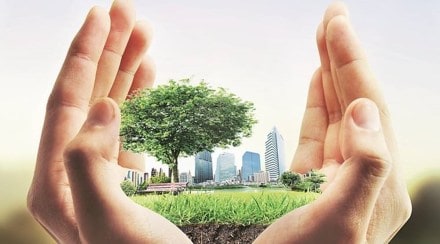– By Pranndeep Singh
In India’s real estate market, sustainability is much more than a passing fad—it is a major driver of the country’s GDP. The industry faces significant obstacles, the most important of which is the impending threat posed by climate change. However, these challenges present India with an incredible opportunity to develop sustainable methods that reduce carbon footprints and maximize the country’s enormous potential for renewable energy. According to McKinsey, the building and maintenance of the built environment is responsible for about 26% of total greenhouse gas emissions and 37% of emissions associated with combustion. Thus, sustainability is becoming a more integral part of the designs produced by Indian real estate companies. This includes large gardens, designs that make the most of natural light, efficient waste disposal systems, water-saving techniques, and carbon-reduction strategies. Such efforts are a result of both the recognition that sustainability offers long-term financial success and environmental imperatives.
The Indian real estate market has recently undergone a significant transformation. Ecological management and sustainability are now squarely in the spotlight. As a result, green real estate has become increasingly well-known due to its eco-friendly design and energy efficiency. Furthermore, the market indicates a rising need for real estate with both observable environmental benefits and significant financial returns. According to IBEF, By 2030, the Indian real estate sector is predicted to be worth $1 trillion, accounting for 13% of the nation’s GDP by 2025.
Here’s a look at how the green revolution is taking over the real estate-
Nurturing the Environment
Selecting environmentally friendly properties reduces carbon emissions, which is the primary objective of green homes. This includes developers making investments in carbon-neutral renewable energy sources like wind and solar electricity. It is essential that sustainability standards are respected at every level of the process, from design to construction and operation. These homes are committed to reducing greenhouse gas emissions, thereby reducing the effects of climate change. This includes selecting sustainable raw materials, making sure they are obtained locally, and designing homes that make use of energy-efficient equipment and fixtures. Thus, by implementing water management systems like rainwater collection, sewage treatment plans, low-flow fixtures, etc., these initiatives also aim to reduce the amount of water consumed.
Considering the Welfare of the Residents
Investing in green homes not only benefits the environment but also allows you to live a better lifestyle. For instance, green homes are typically built to have excellent natural ventilation and lighting, which not only lessens the need for artificial lighting and temperature control but also has numerous health benefits for the residents. Similarly, non-toxic materials are often used in green homes, which helps to create cleaner air while reducing the risk of allergies and respiratory illnesses. Therefore, by including green areas in their designs, such as vertical gardens, green terrace tops, landscaped gardens, etc., these places also encourage responsibility for the environment by fostering the growth of an urban ecology that thrives on pure air. Along with preserving pleasant circumstances, this considerably lessens the heat island effect that modern metropolitan landscapes frequently experience.
The Economic Appeal
Homeowners of today prefer areas that support their ideals of a healthy lifestyle and planet over beauty and comfort. This is the reason why 2024 will see a record-breaking rise in demand for green homes. Environmentally conscious buyers’ increased desire for these spaces, combined with their scarcity, has overshadowed the residences’ perceived added value. In fact, a number of studies indicate that when compared to their contemporary counterparts, green homes typically resell for a greater price. As a result, when the property is sold again, the original premium paid for the green standards is multiplied. Furthermore, a lot of these affordable energy-efficient fixtures raise the general economic appeal of a house.
All Things Considered!
There has been a significant change in India towards healthier lifestyles, as evidenced by the rise in demand for green homes. The emergence of eco-friendly homes becomes more than just a trend as the real estate business consistently shifts its paradigms, it is a commitment to a peaceful cohabitation between modern life and our ecological footprint. Hence, green homes are more than just real estate; they represent a concrete example of a community’s goal for a more sustainable, healthier future.
(Pranndeep Singh is the Director at White Flower Developers.)
(Disclaimer: Views expressed are personal and do not reflect the official position or policy of Financial Express Online. Reproducing this content without permission is prohibited.)
